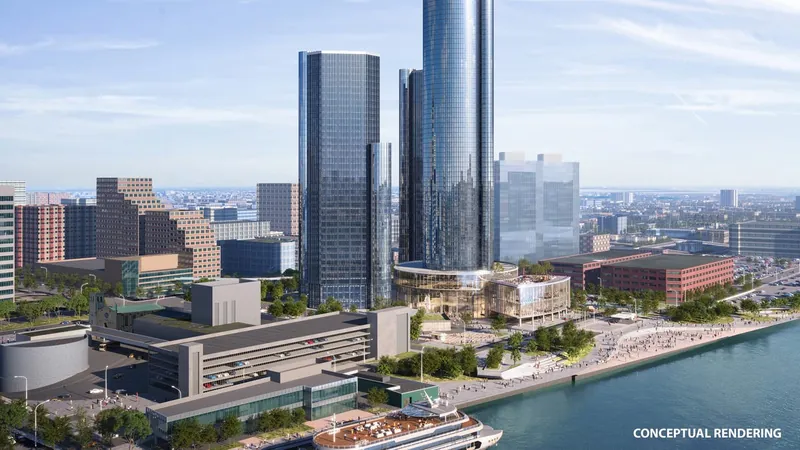
Major Redevelopment Proposal at Renaissance Center: Two Towers to Be Demolished for New Riverfront Park and Residences
2024-11-25
Author: Lok
In a groundbreaking redevelopment plan that could reshape Detroit's iconic skyline, the Renaissance Center (RenCen) is set to undergo a major transformation, reducing its footprint from five towers to three. The proposal, estimated at over $1.6 billion, aims to replace two existing towers with a sprawling six-acre riverfront park, significantly enhancing public access to the Detroit River. This new project hinges on a request for $250 million in state funding, with billionaire Dan Gilbert's Bedrock Detroit LLC joining General Motors Co. as a co-owner of the complex.
Kofi Bonner, CEO of Bedrock, expressed that this endeavor signifies a "right-sizing" of the RenCen for modern urban life, combining residential spaces with commercial and hospitality offerings. The plan will see Gilbert invest a substantial $1 billion in equity and debt, while GM contributes $250 million following its previous investments of $1.5 billion in the facility.
With the rise of remote work trends post-COVID-19, the RenCen's relevance has been called into question, particularly after GM announced it would be relocating its headquarters to the new Hudson's Detroit development in 2024. As part of its transition, GM aims to collaborate with Bedrock to devise a sustainable future for the RenCen within a year.
The blueprints for the redevelopment propose demolishing Towers 300 and 400, creating room for the park connected to the Detroit Riverwalk. This park aims to reflect successful urban spaces like Chicago's Navy Pier or London's O2 Arena, featuring entertainment, dining, and possibly even cultural offerings emphasizing the area's rich automotive history. The iconic central tower will remain, housing a redesigned Marriott hotel which is expected to reduce its capacity from around 1,200 to approximately 850 rooms. Additionally, plans include converting available space into luxury family apartments and residential units.
Further expansion of the area will provide hundreds of residential apartments—anticipated to be around 300 to 400 units—while one tower will remain dedicated to office use, promising to modernize and enhance its appeal amidst the evolving workplace demands.
As demolition could begin within the next two years, city officials and stakeholders are cautious yet optimistic about the implications. Nonetheless, some lawmakers and industry experts have voiced concerns about funding sources, particularly the reliance on taxpayer dollars to revamp private assets. Critics argue that the removal of significant parts of the RenCen will obstruct some of the best views of Detroit's waterfront, potentially impeding future economic returns.
A pivotal sentiment shared among detractors is that while the project's intentions are admirable, it raises eyebrows regarding the necessity and advisability of public financing for a project involving a profitable automaker.
While Bedrock and GM seek to breathe new life into the RenCen area, the broader conversation unfolds within Detroit, which is increasingly looking to its riverfront and waterfront developments as a magnet for tourism and urban revitalization. With plans for long-term growth in mind, stakeholders remain optimistic that the successful redevelopment of the RenCen can further energize downtown Detroit as a thriving hub of residential and commercial activity, encouraging both day and night engagement in the city.
As these discussions advance, the vision extends beyond merely reconfiguring a tower; it aims to reinvent the narrative of what the RenCen can symbolize for Detroit in the coming decades, potentially establishing it as a focal point of urban renewal. The anticipated transformation underscores the city's commitment to enhancing public spaces and redefining its skyline for future prosperity.




 Brasil (PT)
Brasil (PT)
 Canada (EN)
Canada (EN)
 Chile (ES)
Chile (ES)
 España (ES)
España (ES)
 France (FR)
France (FR)
 Hong Kong (EN)
Hong Kong (EN)
 Italia (IT)
Italia (IT)
 日本 (JA)
日本 (JA)
 Magyarország (HU)
Magyarország (HU)
 Norge (NO)
Norge (NO)
 Polska (PL)
Polska (PL)
 Schweiz (DE)
Schweiz (DE)
 Singapore (EN)
Singapore (EN)
 Sverige (SV)
Sverige (SV)
 Suomi (FI)
Suomi (FI)
 Türkiye (TR)
Türkiye (TR)